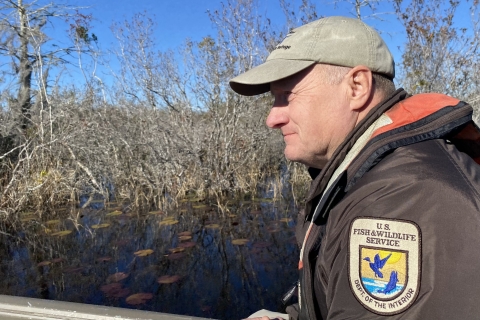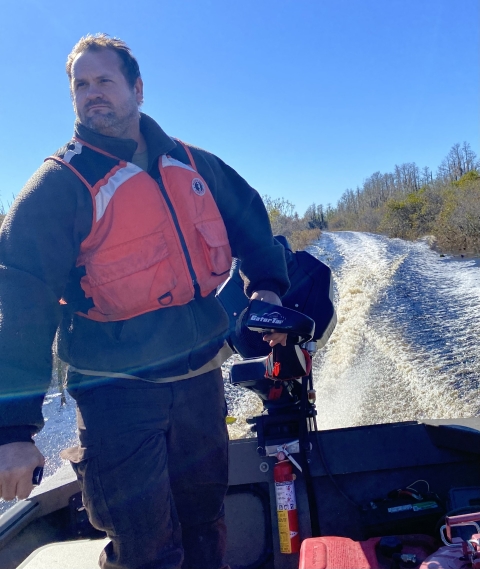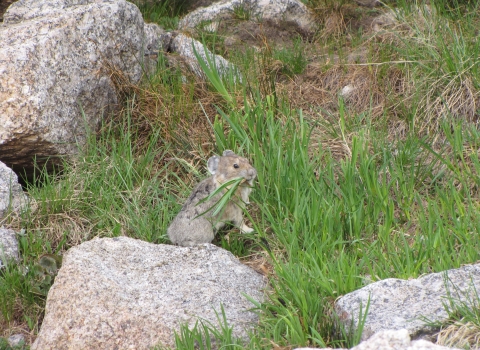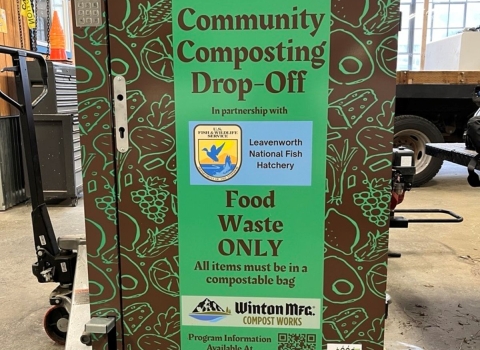Folkston, Georgia — Even on a late-winter morning, the natural charms of the Okefenokee Swamp bedazzle.
A white ibis rises from a bald cypress decorated in Old Man’s Beard lichen. A sluggish alligator — a 10-footer — soaks up the sun alongside broom sedge and yellow-eyed grass. Still-radiant lily pads dot the low-water “prairies” that run miles into the distance.
Yet it’s what’s hidden below the water that’s perhaps the most impressive feature of the 407,000-acre Okefenokee National Wildlife Refuge. There, at densities up to 15 feet, lie millennia worth of decayed vegetation, or peat. The muddy, spongey remnants of dead plants contain millions of tons of carbon that, otherwise, would leak into the air and further the atmospheric decay known as climate change climate change
Climate change includes both global warming driven by human-induced emissions of greenhouse gases and the resulting large-scale shifts in weather patterns. Though there have been previous periods of climatic change, since the mid-20th century humans have had an unprecedented impact on Earth's climate system and caused change on a global scale.
Learn more about climate change .
In fact, the world’s peatlands cover but three percent of the earth’s surface yet hold twice as much carbon as all forests. They are the little-appreciated heroes in the existential fight to save the planet — as long as they don’t burn. If they do, watch out. A 2008-09 wildfire at the Pocosin Lakes National Wildlife Refuge in North Carolina released nine million tons of carbon into the atmosphere.
There is a simple way to keep the peat from burning, though. Just add water, a “nature-based solution” to combat climate change. Without it, the Southeast’s carbon sinks, including Okefenokee, dry up and get exposed to the elements, including wildfires. A warming world increases the likelihood of fire via rising temperatures, withering droughts, and more volatile storms.
Wildlife refuges in North Carolina and Virginia are returning peatlands to their natural, watery states. Okefenokee, though, may face a troublesome future with less water if a nearby titanium dioxide mining project is approved, hydrologists say.
Larry Woodward worries. He fought the infamous West Mims Fire in 2017 which burned for three months, torched 152,515 acres, jumped Okefenokee refuge boundaries, and prompted the evacuation of the town of St. George.
“If it’s dry enough, it’ll burn through these islands, and through this peat, especially with the vegetation as thick as it is now,” said Woodward, the refuge’s deputy manager, while eyeing the cypress snags ringing Monkey Lake. “You'll get 40-, 50-foot flames. It’ll get ugly through here.”
‘Significant public health implications’
Everybody, it seems, wanted to drain the swamp.
George Washington and fellow investors founded the Great Dismal Swamp Company in 1763 and dug miles of ditches which opened thousands of acres for logging and agriculture in Virginia and North Carolina. The Suwannee Canal Company bought the Okefenokee in 1891 with plans for row crops and cypress harvests. The company went bankrupt six years later, yet logging continued a few more decades. And, in the 1960s and 70s, about a third of the current Pocosin Lakes refuge was ditched and drained for easier access to Atlantic white cedar and bald cypress stands. The peat soil, though, proved too difficult to farm and later attempts to harvest the peat as an energy source also failed.
The damage, though, was done. Exposed peat is ripe for catastrophic wildfires that burn hot, long, and unhealthy.
During the 1985 drought in eastern North Carolina, a fire started along Allen Road (then privately-owned land) and burned 100,000 acres, including some peatlands three feet deep.
The Evans Road wildfire began in June 2008 and died out in January 2009. About two-thirds of the 41,500-acre fire happened on the Pocosin Lakes refuge. Smoke reached Raleigh 150 miles to the west.
Researchers in 2011 reported that emergency room visits for asthma, COPD, pneumonia, acute bronchitis, and heart failure rose significantly within five days of exposure to wildfire smoke in the sparsely populated counties surrounding Pocosin Lakes. The study, in the Environmental Health Perspectives journal, concluded that the rise in ER visits due to exposure to peat bog smoke “is striking and persuasive and has potentially significant public health implications.”
The climate benefits of keeping carbon in the ground are manifold: lower air, ocean, and groundwater temperatures; fewer deluges of rain; slower rising seas; more snow cover; sturdier glaciers; more sea ice.
“When we think about doing nature-based solutions, at a meaningful scale, we can address climate goals, and risks, and also build healthier communities through clean water, clean air, and access to recreational benefits,” said Sara Ward, the nature-based resiliency coordinator for the U.S. Fish and Wildlife Service. “And by restoring the loss of natural features we really can provide a suite of ecosystem benefits for local communities and the wildlife and plant species that we manage.”
Nature is the answer
A pocosin is a peatland, or a “swamp on a hill,” according to Eastern Algonquian Indians, though the eye has a hard time discerning any altitudinal change across the low-lying, shrubby wetlands of eastern North Carolina. Peatlands cover 90 percent of Pocosin Lakes’ 110,106 acres.
Since the Allen Road fire in 1985, the Service and conservation partners have unveiled a series of nature-based solutions at the refuge. Plugging ditches and installing water control structures keeps the peat wet, the carbon covered, and the water (all rainwater) to flow slowly into the Albermarle and Pamlico sounds. Water management also provides prime waterfowl habitat during winter months when the fields and skies fill with tundra swans, snow geese, and other ducks. Roughly 37,000 acres of peatlands have been restored at Pocosin Lakes.
A 2022 study by Duke University concluded that rewetting 250,000 acres of southeastern peatlands could prevent 4.3 million tons of carbon from escaping into the atmosphere.
“Carbon sequestration is a very important benefit for us, but it’s a secondary benefit,” said Wendy Stanton, refuge manager at Pocosin Lakes. “We want to minimize the risk of catastrophic wildfire. And the water-quality benefits of restored peatlands are very significant. By rewetting, we are creating healthy pocosin wetlands which provides habitat for many different species of wildlife.”
More nature-based, habitat-improving, carbon-sequestering remedies are in the offing. The Service received $27 million last year from the Inflation Reduction Act to fight climate change across the Albemarle-Pamlico region. The nine wildlife refuges in eastern North Carolina will get the bulk of the money. Water control structures — dikes, canal plugs, flashboard risers, maybe a low-level berm — might be added or replaced at Pocosin Lakes near Evans Road.
Rewetting works. Lightning ignited the Ferebee Road Fire in June 2022 on private land adjacent to the refuge. Nearly 2,000 acres burned, yet the fire quickly went below ground into the peat and released tons of additional carbon. The same storm sent four lightning bolts onto Pocosin Lakes, about 1.5 miles from the farm fire.
“Our peat did not ignite because we had restored the hydrology in that area,” Stanton said.
That same year the Service and the U.S. Geological Service published in the scientific journal PLOS One a detailed assessment of the climatic, and financial, benefits of sequestering carbon on 364 refuges nationwide. Peat, trees, shrubs, and soils store 16.6 billion metric tons of carbon, according to Conservation of carbon resources and values on public lands: A case study from the National Wildlife Refuge System.
By comparison, the global amount of carbon dioxide emitted from fossil fuels last year was 37.4 billion tons.
The study also delved into the benefits plants and trees provide by keeping carbon in the ground, and by pulling it out of the atmosphere. Put another way, each additional ton of emitted carbon comes with a price we must pay. More trips to the doctor. Higher produce prices. Costlier air pollution controls.
The sequestered carbon on the refuges contributes $976 million annually in benefits to society, the study says. (National parks offer an annual benefit of $582 million.) Great Dismal Swamp alone accounts for $11 million in savings.
“One thing we’ve done — it's unequivocal — is improved our ability to fight ground fires on these landscapes,” said Fred Wurster who worked as a hydrologist at Great Dismal for 11 years. “We’ve done triage on the ecosystems, and we’ve stopped the worst of the damage caused by drainage. But to get the system back to healthy-patient mode we have a lot more to do.”
The restoration challenge
A 150-mile network of ditches crisscrossed Great Dismal when it was established in 1974. In 2011, lightning started a fire that raged 111 days. The Lateral West Fire burned 6,500 acres and burrowed deep into the peat. Hurricane Irene dumped a foot of rain yet couldn’t extinguish the inferno. More than one million tons of carbon went up in smoke.
Forty-five water-control structures have since been added at Dismal Swamp. In all, 75 of the structures slow drainage and help keep wet much of the 113,000–acre refuge. The restored peatlands sequester 200,000 tons of carbon each year, enough carbon to offset the annual emissions of 42,000 cars.
Dikes alone, though, can’t return Great Dismal to its ecological glory.
“The narrative is, you plug the ditches, rewet the swamp and it’s restored, but it’s not quite that simple,” said Wurster, now a Service geomorphologist helping East Coast refuges deploy nature-based solutions to solve their water, fire, and carbon woes. “We’ve definitely improved the hydrology, no doubt about it. But there’s been so much damage to the swamp over the decades that we’ll have to take much more drastic measures to get closer to full hydrological restoration.”
Two-hundred and fifty years of drained pocosins have seriously degraded the top two feet of peat. They’ve lost their capacity to hold water, a condition Wurster fears is permanent. Climate-induced, longer-term droughts further dry the soils. And the burned peat isn’t rejuvenating, either. One survey deduced that the Lateral West Fire reduced the mean elevation of the area burned by 47 centimeters.
The forest, too, is different. What was once a wild and wet whirl of Atlantic white cedar, bald cypress, and swamp tupelo is now predominantly red maple and scattered pine. The refuge is trying a slew of additional nature-based solutions: thinning out red maples; planting white cedars; and prescribing fire in certain locations. Wurster says ditches might need to be filled in and roads taken out to better manage water flow.
“The bottom line,” he said, “is that it’s really challenging to get full restoration.”
Titanium and toothpaste
There’s a whole language around peat in the Okefenokee Swamp. Clumps of the organic matter sitting on the water are called “blowups.” As they get bigger and gain moss, sedges, and shrubs, they become “batteries.” And once they’re big enough to host trees they’re called “houses.”
“Everything you see here is growing up on peat,” said Woodward, the refuge deputy manager, alongside a battery with a friendly alligator lolling nearby. “You got a lot of blowups there. And see those cypress trees over there? Those are peat islands.”
Woodward and Zach Carter, a ninth-generation swamper and refuge Jack-of-all-trades, parked their skiff on Chesser Prairie, along the southeastern edge of the Okefenokee refuge. Locals label the low-lying ponds and marshes “prairies” which might confuse an outsider, but no matter. Because it’s what lies below the prairies, and on top of the prairies, that’s most relevant: at least 95 million tons of carbon – more stored carbon dioxide than any other peatland between Massachusetts and Texas.
The Okefenokee, one of the largest intact freshwater ecosystems in the world, was never ditched and drained like Great Dismal or Pocosin Lakes. Logging notwithstanding, the 630-square-mile refuge has remained relatively pristine over the centuries.
It was established in 1937 as a “refuge and breeding ground for migratory birds and other wildlife,” including federally threatened or endangered red-cockaded woodpeckers, wood storks, eastern indigo snakes, and American alligators. (About 15,000 at last count.) It’s the blackwater headwaters of the Suwannee and St. Marys rivers. It’s a Wetland of International Importance and a United Nation’s World Heritage Site nominee. Roughly 400,000 people each year visit the refuge to canoe, camp, birdwatch, hunt, fish, and gape at the incredible biodiversity.
And, according to its supporters, it’s imperiled by plans to strip mine for titanium dioxide and other heavy minerals less than three miles from Okefenokee’s southeastern border. Alabama-based Twin Pines Minerals seeks a permit from the state of Georgia to establish a 582-acre “demonstration area” to prove that mining so near the swamp won’t harm the refuge, its hydrology in particular. Twin Pines, eventually, wants to mine thousands of additional acres along an ancient barrier island called Trail Ridge. The ridge, though, acts as an earthen dam blocking the swamp from draining to the east.
Georgia’s environmental regulatory agency proposed draft mine permits in February. It will take written comments from the public on these permits until April 9.
Titanium is used in airplanes, jewelry, and golf clubs, but most commonly as a whitening compound for toothpaste, paint, sunscreen and other household products. Critics say the Okefenokee is too precious to jeopardize for toothpaste.
Twin Pines plans to tap the Floridanaquifer each day of more than 1.4 million gallons of water to keep its mining pits dry. The aquifer also underlies the Okefenokee. Georgia regulators say water levels in the swamp “will be minimally impacted.” Hydrologists with the National Park Service and at 10 universities say the data used by Georgia was flawed and unreliable.
“There is currently not enough information to properly evaluate the effects of withdrawing 1.44 million gallons of water per day from the Floridian aquifer,” said Michael Lusk, the refuge manager. “The project has the potential to significantly impact the swamp’s ecosystems and habitats.”
A water withdrawal of 1.4 million gallons a day would leave the already shallow southeastern corner of the swamp drier for longer periods of time, according to two Georgia hydrologists. Over time, four feet of peat is likely in jeopardy. And, with it, 28 million metric tons of carbon dioxide – one-quarter of Georgia’s annual carbon emissions -- could seep into the atmosphere, according to the U.S. Energy Information Administration.
“And the wildfires would be out of control,” Woodward said.








